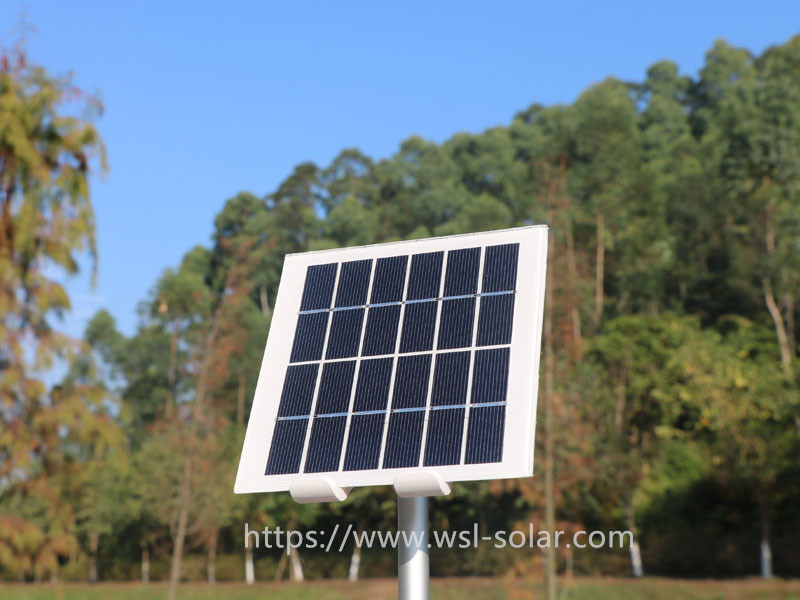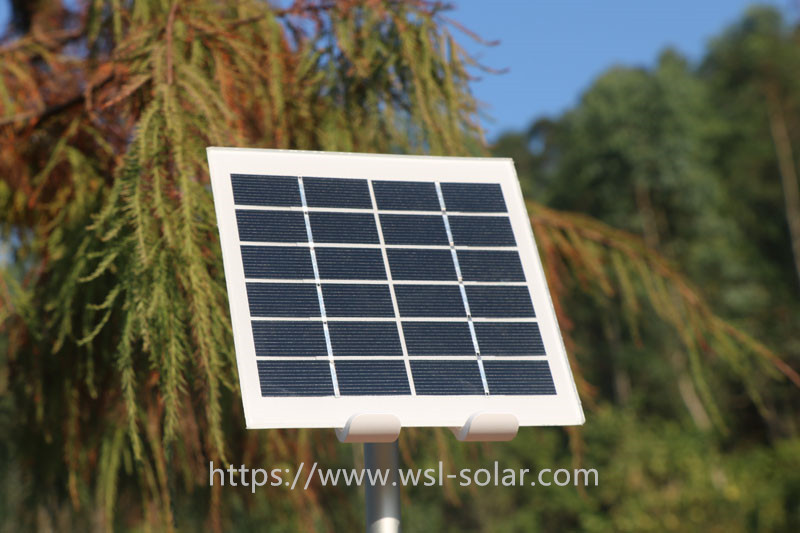WSL Solar Co., Ltd.
In practical applications, the power generation performance of photovoltaic power generation systems is greatly affected by natural environmental conditions. The operating temperature of the main components of the system – solar PV modules and batteries, is one of the important factors affecting the performance of photovoltaic power generation systems.
1. Temperature effect of silicon solar cells
The core unit of solar photovoltaic power generation is solar cells. Currently, large-scale commercial applications are mainly silicon-based solar cells: monocrystalline silicon solar cells, polycrystalline silicon solar cells and amorphous silicon solar cells. The influence of temperature on silicon solar cells is mainly reflected in the change of parameters such as open circuit voltage, short circuit current and peak power of solar cells with temperature.

Small Solar Panel from WSL Solar
1.1. The impact of temperature on the single solar cell
The open circuit voltage of the single-cell solar cell decreases with the increase of temperature, and the voltage temperature coefficient is -(210-212)mv/°C, that is, the temperature of the open circuit of the single-cell solar cell decreases by 210-212mv for every 1°C increase in temperature; The short-circuit current of a solar cell rises as the temperature increases; The peak power of the solar cell decreases with the increase of temperature (directly affects the efficiency), that is, for every 1 °C increase in temperature, the peak power loss rate of solar cells is about 0135~0145%. For example, a silicon solar cell operating at 20 ° C has an output power 20% higher than that at 70 ° C.
1.2. The impact of temperature on custom solar modules
A single solar cell module is usually composed of 36 single-cell solar cells connected in series. According to the results of field measurements in Xining, the solar cell module back surface temperature can reach 70 ° C in summer, and the solar cell operating junction temperature can reach 100 at this time. °C (rated parameters are rated at 25 ° C), the open circuit voltage of this component will be reduced compared to the rated value:
213×(100-25)×36=6210mv
Peak power loss rate is approximately:
14% × (100-25) = 30%
It can be seen that when the silicon solar cell is operated at a high temperature, the open circuit voltage drops sharply with the increase of temperature, and at the same time, the charging working point is seriously offset, which is easy to damage the system due to insufficient charging; The output power of silicon solar cells also drops sharply with increasing temperature, resulting in solar modules failing to maximize their maximum performance.

6V Solar Panel from WSL Solar
2. The temperature characteristics of the battery
In the independently operated solar photovoltaic power generation system, the battery is a key component, its main function is to store and regulate electric energy. At present, there is no special battery for solar photovoltaic power generation system in China, but a conventional lead-acid battery, the main types are: fixed lead-acid batteries, industrial sealed batteries, small sealed batteries, start-up batteries, etc. Temperature is one of the main factors affecting battery life.
2.1. The nature of the temperature characteristics of lead-acid batteries
The lead-acid battery is a chemical battery, which is composed of a pole group inserted into a dilute sulfuric acid solution. The positive plate is lead dioxide and the negative plate is spongy lead. During the discharge, the effective substances of the two electrodes react with sulfuric acid to convert to lead sulfate. When charging, it returns to the original lead and lead dioxide. So when the electrolyte temperature is high (within the allowable temperature range), the ion movement speed is increased, the obtained kinetic energy is increased, so the penetration force is enhanced, thereby reducing the internal resistance of the battery. The diffusion rate is accelerated and the electrochemical reaction is strengthened. When the electrolyte temperature drops, the penetration force decreases, the internal resistance of the battery increases, the diffusion speed decreases, and the electrochemical reaction is sluggish.
2.2. The relationship between charging voltage and temperature
In order to ensure the performance of the battery, the battery needs to change the charging voltage according to the temperature change of the battery. The compensation coefficient of the unit voltage is -(3~7)mv/°C. Generally, when the battery is used in a circulating state, the cell voltage temperature compensation coefficient may be -4mv/°C; When used in the floating state, the unit voltage temperature compensation coefficient is taken as -315mv/°C;
When performing equalization, the cell voltage temperature compensation coefficient is -5mv/°C..
2.3. The relationship between battery capacity and temperature
The operating temperature of the battery has a great influence on the battery capacity. In different temperature ranges, the influence coefficient of temperature on the capacity is different. When the temperature is low, the capacity of the battery increases with the increase of temperature. However, too high temperature will also have an adverse effect on the battery, resulting in a decrease in battery capacity and a shortened life. The following table shows the ratio of the effective discharge capacity to the rated capacity of the battery under different temperature conditions provided by a lead-acid battery factory (the rated capacity is 25 ° C, the battery discharge The 10-hour discharge capacity of the battery with a termination voltage of 118V).
On the other hand, it can be seen from the above table that the lead-acid battery is not suitable for working at a lower temperature for a long time. For example, the discharge capacity only reaches 30% of the rated capacity at -30 °C, and the maximum performance of the battery cannot be exerted. Other types of batteries should be considered for low temperature applications.
2.4. The relationship between battery life and temperature
The floating life of the battery changes with the change of temperature. Basically, for every 10 °C increase, the floating charge life is reduced by about half. The high temperature accelerates the battery water loss, thermal runaway, positive grid corrosion and deformation. Low temperature will cause negative passivation failure, temperature fluctuation will accelerate internal short circuit of lead-acid battery, etc., which will affect battery life.
2.5. The relationship between self-discharge and temperature
The self-discharge of the battery is related to the manufacturing material and storage time. The temperature is the main factor affecting the self-discharge of the battery. The higher the temperature, the higher the self-discharge rate of the battery. Therefore, the battery should avoid long-term storage in a high temperature environment.
3. Conclusion
The temperature influence of solar photovoltaic power generation applications is mainly reflected in the changes in the electrical properties of solar cells and batteries as a function of temperature, thereby affecting the power generation performance of the entire photovoltaic system. But these effects can be basically improved by reasonable system design and charge and discharge controller design.
3.1. Reduce temperature effects by properly designing and installing solar modules
System design (especially when there are series and parallel arrangement of solar modules to form a solar array), the number of solar modules should be appropriately increased according to the use environment to compensate for the voltage loss and power loss caused by the increase in temperature, to ensure the normal use of the system; At the same time, the installation of the solar cell module should fully consider the heat dissipation problem, especially when the solar cell module is installed in combination with the building, sufficient space for heat dissipation should be left.
3.2. Reasonable design of charge and discharge controller for solar photovoltaic power generation
Realize the maximum power tracking (MPPT) function of the solar cell array to accurately track the working voltage and power fluctuations, and maximize the performance of the solar cell. Increase the temperature compensation function to automatically adjust the battery charging voltage and the discharge termination voltage under different temperature conditions. If it is possible to set the overdischarge control according to the battery capacity, the performance of the battery should be properly utilized.
3.3. Design a reasonable computer room, try to control the indoor temperature within the appropriate range.
Especially in the cold regions, passive solar heating rooms should be used, and the batteries should be operated at an ambient temperature of 5 °C ~ 35 °C.
3.4. In solar photovoltaic power generation applications, in addition to affecting the electrical performance of solar cells and batteries, in the construction of independent photovoltaic power plants, the construction of solar houses, the laying of wires and cables, and the construction of array foundations should all consider the influence of temperature.
Author: Carrie Wong
From WSL Solar Co., Ltd.
WSL Solar has been a quality and professional manufacturer of customized solar panels (or custom PV modules) and solar solution provider in China since 2006. With our in-house R&D team and management team for over 10 years' experience in solar industry, we are able to design and develop a customized solar module in a variety of sizes, shapes and outputs to meet our client's specific requirement, and provide solution support start from initial product development stage. For more detail, please visit https://www.wsl-solar.com/
WSL Solar Main Solar Panels:
5V Solar Panel
6V Solar Panel
9V Solar Panel
12V Solar Panel
18V Solar Panel
1W, 2W, 2.5W, 3W, 5W, 10W ... 100W solar panels